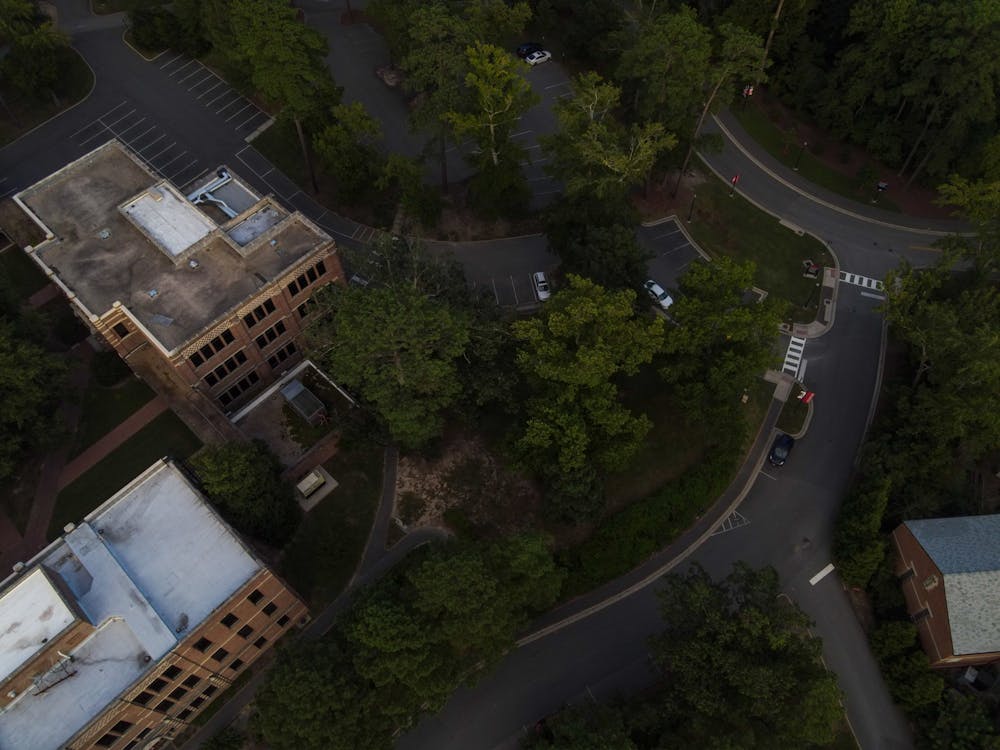Growing up in the Richmond area, Kent Taylor Sr. formed strong bonds within the Baptist community. Some of those bonds have grown to be almost familial ever since he found out he is one of the descendants of the enslaved people whose final resting place could be the Westham Burying Ground.
“The funny thing is, a lot of us know each other, and a lot of us consider ourselves family already,” Taylor Sr. said. “When I see all these folks, even if I don't know them, I know their faces.”
Joined by a group of fellow descendants, Taylor Sr. paced around the scarlet carpet of Pilgrim Journey Baptist Church on Feb. 11. Together, they envisioned what a memorial to their ancestors — whom the majority of descendants did not know existed until a few years ago — could look like. What stories would its walls tell? How would it honor Black people? What would the gates guarding the sacred space look like?
He sat on a pew and jotted down his thoughts on post-it notes. Descendants stuck the notes on boards set up by Baskervill, the architecture firm behind the design and construction of the memorial. The boards, which crowded the front of the church, explained the site plan and provided options for the granular details of the burial ground memorial that will be built on the hill behind Fountain Hall.

Kent Taylor Sr. sticks a post-it note on a design concept at the Feb. 11 information session. Descendants provided feedback on the portrait options that will be displayed on the walls of the memorial.
“This is us walking into the space,” lead architect Burt Pinnock said as he pointed to a video simulation playing on a TV. The simulation transforms a small parking lot into a courtyard entrance facing UR Drive. Through the educational space in the courtyard, gates lead to a vestibule that will focus on portraits and names. The final look of the gates is yet to be chosen, though potential designs drew inspiration from Benin and Igbo art.
Yet, the portrait concepts and other aspects descendants could provide feedback on — including a tree to symbolize the new beginning for the 200-year-old oak tree on the premises — are not definitive options.
“I wouldn't say it's an either/or,” Pinnock said to Taylor Sr. who asked if the designs displayed were the only options. “It might be a both/and, might be a neither/but.”
Enjoy what you're reading?
Signup for our newsletter

A miniature 3D model of the memorial site plan. The design consists of two intercepting ovals. The photo was taken on Feb 11. at the Pilgrim Journey Baptist Church.

Aerial view of the Westhampton burial ground
Although the design of the memorial has trailed away from the three concepts Baskervill unveiled just over a year ago, keeping a light touch in the construction has remained a top priority for the descendants, architects and UR representatives, which is reflected in the site plan to leave the cemetery portion largely untouched. Upholding this principle is essential so as to not disrupt any burials, since attempts to find their exact location using ground-penetrating radar yielded inconclusive results, according to the Burying Ground Memorialization Committee’s final report.
That does not mean that there are no human remains in the area, but that its evidence lies mainly within historical records. That history was not publicly acknowledged by UR until former graduate student Shelby Driskill published the findings of her investigation in 2019. Then came the formation of the committee and the publication of the final report by Driskill and history professor Lauranett Lee.
Four years after the UR community started to grapple with the rediscovery of the burial ground, Driskill still wows people as she succinctly recites the entire history of the burial ground off the top of her head. Although ownership of the land UR occupies has changed numerous times, Driskill explained to the group of descendants that records show that in 1912 the Board of Trustees was notified about the existence of at least 20 burials on the site. The uncertainty of the number and identities of those buried in the Westham Burying Ground means that the search for descendants will continue.
Building a community of descendants has largely been the work of Brenda Dabney Nichols. The author of “African Americans of Henrico County” formally serves as a consultant to the committee, but to most of the descendants, she is the first point of contact to the burial ground. Her deep devotion to recording African American history in the Richmond and Henrico area is also personal. She is a direct descendant of Henry Pryor, a formerly enslaved person, who created Ziontown — a community built for and by Black people in what is now the Ridge Road area, according to the final report.
“I plan to stay with it until it's over, come hell or high water,” Dabney Nichols said in her opening remarks at Pilgrim Journey Baptist Church. “We're going to just do this all together.”
Both Taylor Sr. and Yvette Pryor Ohree, who is also a descendant of Henry Pryor, found out about their connection to the Westham Burying Ground when Dabney Nichols contacted them. Dabney Nichols joked about the effort it takes for her to rally the descendants together.
“I’ve sent out so many emails, I probably bore them to death, but oh well, whatever,” she said. “But, sometimes you have to do that because some people don't read the first one.”
Eight months ago, Taylor Sr. found out that his ancestor, Charles Carter, was enslaved by the Green family, who owned land that UR occupies from 1848 to 1901, according to the final report.
“I feel like there's some actual evidence of our connection,” Taylor Sr. said about the sense of community he feels with the other descendants.
Since then, he has visited the burial ground. He tried to put himself in the shoes of Carter, he said.
“You just kind of try to put yourself in that space at that time,” he said. “I really couldn't imagine that. You really try to understand what their lives must have been like.”
Pryor Ohree shared conflicting feelings about the trajectory of the burial ground. She was happy to be able to visit the site but saddened by the trauma of the people buried there, she said.
“I had no idea that we had the history at the University of Richmond,” she said. “I didn't know that there was any type of burial ground and just listening to the history seems to be they knew what was there and did nothing, really, to preserve it.”
Once the memorial is complete, it will become part of the campus landscape changes UR has made since 2022 to atone for its links to slavery. During the past year, UR has changed the names of seven campus buildings because of the namesakes’ roles in slavery and eugenics. The decision to rename the law school because of T.C. Williams’ enslavement of at least 43 people has angered the benefactor’s descendants.
While the Westham Burying Ground descendants begin to uncover the ignored history of their ancestors, Williams’ family members are demanding that UR give back the donations he made. They first claimed to The Richmond Times-Dispatch that they are owed $51 million, and less than a week later told The Washington Post that the value of the donations would equal $3.6 billion today.
Taylor Sr. said he understood how Williams’ family felt but, ultimately, disagreed with their opinion.
“I think it's a bigger picture that they're missing,” he said. “I think the bigger picture is what that name represents to human beings. … I think if they really thought it through, really prayed on it and all, they would reconsider.”
As UR and the city of Richmond continue to reckon with the legacy of slavery and the Confederacy, acknowledging pain through building the Westham Burying Ground memorial is a baby step in the right direction, descendants said.
“In this climate, right now, there's so much going on,” Pryor Ohree said. “We still got a long road to go.”
For now, UR community members will be able to continue to provide feedback for the design of the memorial. The next information session will be held from 7-8 p.m. on Feb. 21 on Zoom.
In a perfect world, Baskervill will be able to start construction in the fall, Pinnock said.
Contact writer Jackie llanos at jackie.llanoshernandez@richmond.edu.
Support independent student media
You can make a tax-deductible donation by clicking the button below, which takes you to our secure PayPal account. The page is set up to receive contributions in whatever amount you designate. We look forward to using the money we raise to further our mission of providing honest and accurate information to students, faculty, staff, alumni and others in the general public.
Donate Now



